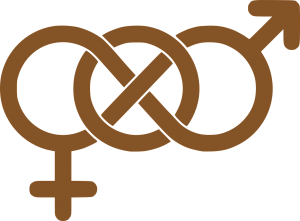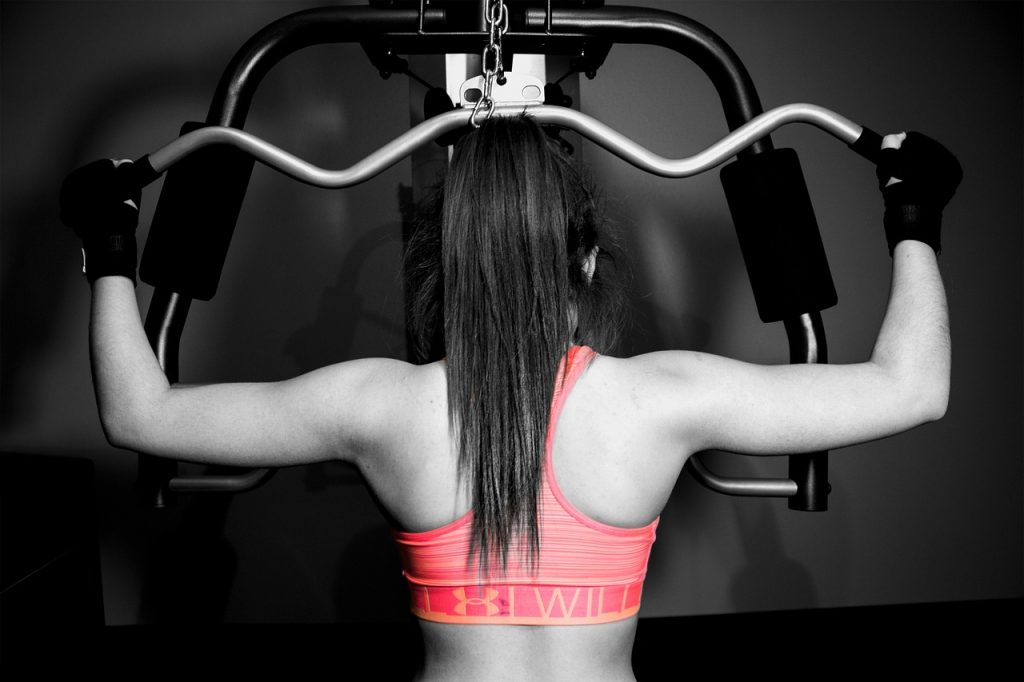Despite its reputation in pop culture & mass media, testosterone is not confined to the health status of sweaty, hairy, monosyllabic men. In reality, when you chalk up the various powerful feminine attributes in which testosterone plays a huge role, the male monopolized view on the hormone comes across as a little… well, absurd.
Sex. Ambition. Cognition. Physical prowess. Feelings of well-being.
These are the markers of healthy testosterone levels, regardless if you’re a younger woman or an older man. An older woman or a younger man. A medium-sized dog or a three-eyed cat.
Testosterone is testosterone. And most of us these days could perhaps use a little more.
Testosterone is a Female Hormone

On average, men have more testosterone than women.
This is true.
But having less T doesn’t mean it’s less important for women’s health—likewise, having less estrogen doesn’t mean estrogen is less important for men’s health. Despite being labelled as an androgen, which constitutes a class of “male” oriented sex hormones, testosterone is very much a female hormone as it is a male hormone for its integral role in maintaining the following aspects of female health:
- Mood
- Energy
- Sex Drive
- Cognitive Health
- Muscle Development
And depending on the stage of menstruation & menopausal status, optimal testosterone levels widely vary—however, one constant factor is the discrepancy between “Total T” & “Free T”:
- Total T is the net amount of T at any given point.
- Free T is the amount of bio-active T at any given point.
In both men & women, the amount of Free T encompasses only a sliver-sized slice of Total T–on average lying in the 1-2% range of Total T. This is due to sex hormone-binding globulin (SHBG), a glycoprotein that binds & thus deactivates sex hormones (namely T, DHT, & estrogen). When hormones are out of whack, SHBG is designed to place them back into whack by binding & transporting them to locations of need.
But what happens when SHBG is out of whack?
The Female T Dilemma

Women naturally have more SHBG than men.
SHBG naturally has a higher affinity to testosterone than estrogen.
Increased estrogen levels increase SHBG levels.
Now, while these three points don’t inherently add up to a problem, they certainly establish the risk of one–particularly when that problem is Low Female Testosterone. Therefore, if SHBG increases, estrogen increases, overall T production decreases, or any combination of these effects occurs, T expression is likely to diminish.
Conversely, excess T levels may induce negative effects on estrogen, SHBG, & other hormones, which has influenced researchers to craft the “Four-Level-Hormone” classification scheme to simply identify when T & estrogen are out of balance. The four levels include:
- Low E – Low T levels are correlated with osteoporosis, depression, and obesity
- High E – Low T with obesity and decreased libido
- High T – Low E with aggression, depression, increased libido, and substance abuse
- High E – High T with type II diabetes risk and cardiovascular risk1
In later years, particularly during & after menopause, incidence of low T + low E becomes more prevalent–a significant risk factor for both sexes. However, because T is more often associated with male health, it’s often overlooked by women–even though T levels seem to continuously decrease to about 50% before menopause (when compared to a healthy 20-year old).1
Who is at Risk of Low Testosterone?
The women who are most at risk of Low-T are menopausal women–yet, other risk factors & associations include:
- Long-term oral contraceptive consumption
- Undernourishment (i.e. anorexia)
- Excessive weight gain (i.e. obesity)
- Synthetic estrogen or thyroid hormone treatment
- Chronic stress
Symptoms of Low Testosterone in Women
Here are a few common symptoms of T deficiency in women:
- Chronic Fatigue
- Diminished Motivation
- Difficulty Losing Weight
- Decreased Sex Drive
- Mood Swings
- Anxiety & Depression3
In later years, abnormal testosterone levels may also aggravate menopause symptoms (e.g. hot flashes, sleep disturbances, vaginal dryness, hair loss, osteoporosis, etc.)—often times having a direct correlation with these conditions.
Fortunately, T-boosters may help.
How T-Boosters Might Help Female Health
Despite what the name implies, the “T-boosters” that we’re referring to are less boosters than they are regulators. As such, these T-boosters work as useful alternatives to Testosterone Replacement Therapy (TRT), anabolic steroids, and other forms of synthetic testosterone infusion that may spike T beyond functional levels.
Additionally, T-boosters often regulate other important hormones & bio-pathways, resulting in the following benefits:
Increased Sex Drive & Function
One of the most voiced complaints by women with low T conditions: Diminished sex drive.
Due to the physiopsychological nature of sex drive, it’s not always so simple as pinpointing testosterone as the single cause of libido–but regulating T levels does seem a viable option in alleviating conditions of low libido.4 With that in mind, natural T-boosters may help to not only increase sex drive, but may enhance sexual function (e.g. by increasing blood flow to the regions that matter most to sex).
Modulated Energy Metabolism
In The Study of Women’s Health Across the Nation (SWAN), 359 women, aged 46 – 60 years, were randomly selected to complete a community consensus exploring the relationship between visceral fat, metabolic syndrome, diabetes, and cardio health–particularly in relation to bio-available T & estradiol.
By the conclusion of the study, T was found to play a more important role in regional fat distribution (i.e. how much fat gets distributed to the mid-section vs. elsewhere) than estrogen.5 As such, this seems to partially explain the often-cited fat-burning qualities of T-boosters used by women.
Decreased Stress Hormone Cortisol
Adaptogenic herbs & compounds often make these lists simply due to the fact that normalizing stress hormone levels has frequently been demonstrated to optimize numerous aspects of health–including sexual health.
In certain cases, the ratio between T & stress hormone cortisol is just as much of an indicator of female health as is the T:estrogen ratio. While all women could potentially benefit from adaptogens, active women at risk of increased, ongoing stress levels would do best by a T-booster of this nature.
List of T-Boosters for Women
While most T-boosters primarily recognized as “T-boosters” are predominantly studied for male health conditions, there are a number of natural herbs & compounds that seem to aid female health as well—occasionally benefiting female health despite holding a “questionable” status for male health.
Here are a few T-boosters that may benefit female health:
Tongkat Ali
![By Franz Xaver (selbst fotografiert - my own photo) [GFDL or CC-BY-SA-3.0], via Wikimedia Commons](https://supplementsinreview.com/wp-content/uploads/2016/10/Eurycoma_longifolia_1-300x177.jpg)
Additionally, in a separate placebo-controlled study on “mildly stressed” men & women, Tongkat Ali was shown to significantly improve the salivary stress hormone profile by:
- -16% cortisol
- +37% testosterone
- -36% cortisol:T ratio7
As a result, Tongkat Ali seems to help female health by not only increasing libido & free T expression, but by diminishing the harmful, catabolic effects of stress—even during non-active (i.e. exercise-free) conditions. More on Tongkat Ali.
Ashwagandha
![Ashwagandha is an important herb to the ancient Ayurvedic health system. By The original uploader was F16 at Hebrew Wikipedia (Transferred from he.wikipedia to Commons.) [GFDL or CC-BY-SA-3.0], via Wikimedia Commons](https://supplementsinreview.com/wp-content/uploads/2016/10/Godofayurveda-173x300.jpg)
Strictly in terms of female sexual health, Ashwagandha’s adaptogenesis has been observed to improve the female body’s physical & psychological condition with regards to sexual function—giving this T-booster a nootropic edge on women’s health for its psychosexual support.8
Additionally, Ashwagandha’s bio-effects stretch across a wide age spectrum, helping younger women as well as post-menopausal females—one clinical study in particular suggesting that Ashwagandha alleviates mild to moderate symptoms, both somatic & psychological, of menopausal syndrome.9 As such, Ashwagandha makes for a great addition to any age/gender-specific stack of supplements. More on Ashwagandha.
Tribulus Terrestris
![Stan Shebs [GFDL, CC BY-SA 3.0 or CC BY-SA 2.5], via Wikimedia Commons](https://supplementsinreview.com/wp-content/uploads/2016/10/Tribulus_terrestris_5-300x266.jpg)
Because Tribulus Terrestris doesn’t really boost T.
But it is a potent sex-enhancing herb that, while not increasing any sex hormone numbers, may help increase sex hormone expression by enhancing androgen receptors in the body. Thus, encouraging the body to use testosterone & other hormones more efficiently.10
Take note: While a rather comprehensive journal review found no currently significant evidence to support Tribulus’ usage in sports nutrition11, the herb was found in a separate study to be “safe and effective in the treatment of female sexual dysfunction”12—independent of T levels. More on Tribulus Terrestris.
Damiana Leaf
![By Nordschitz (Own work) [CC BY-SA 4.0], via Wikimedia Commons](https://supplementsinreview.com/wp-content/uploads/2016/10/Turnera-diffusa-IMGP5956-300x199.jpg)
Yet, it earns a spot on this list for its popularity among women as well as the sparse research that suggests Damiana (combined with primrose oil, ginseng, & royal jelly) may “be used as a safe natural promoter of health and well-being in women during the menopausal transition.”13 But how does it do this? The current theories:
- Increases vasodilation via increased nitric oxide levels, resulting in increased blood flow throughout the body.
- Inhibits aromatase for more T & less estrogen—although, a number of Damiana’s compounds were found to possess potentially pro-estrogen bio-activities.14
Whatever those estrogenic activities might entail remains largely unknown, but this seems to be more of a concern for male health than women’s health. More on Damiana Leaf.
Diindolylmethane
![By Fvasconcellos (talk · contribs) (Own work) [Public domain], via Wikimedia Commons](https://supplementsinreview.com/wp-content/uploads/2016/10/1200px-33-Diindolylmethane.svg_-300x155.png)
- Releasing T from overactive sex hormone-binding globulin (SHBG)
- Inhibiting aromatase from converting T to estrogen
- Regulating levels of “bad” and “good” estrogens15
Particularly through this last bio-effect—the modulation of “bad” unmetabolized estrogens into “good” 2-hydroxy estrogen metabolites—Diindolylmethane not only sustains healthy T levels, but reduces the types of estrogens most associated with auto-immune disorders, obesity, & environmental chemicals. More on Diindolylmethane.
Vitamin D
![See page for author [CC BY 4.0], via Wikimedia Commons](https://supplementsinreview.com/wp-content/uploads/2016/10/A_lady_sunbathing_on_the_beach_Wellcome_L0074515-197x300.jpg)
Known as the “sunny” vitamin, Vitamin D has a strong association with testosterone levels in both men & women and can be supplemented either orally or… solarly (how many supplements can claim that?). Yet, in older age, Vitamin D supplementation becomes a more pressing issue due to its link with T levels & bone health:
- In a study on 65+ year old men & women, the highest-risk demographics of low T & low Vitamin D levels, the combination of Vitamin D & Calcium was observed to increase the quality of life past 65, as evidenced by increases in T and decreases in “risk of fall.” In conclusion, the researchers stated, “With [Vitamin D + Calcium] the anti-fall benefit of higher physiologic testosterone levels is enhanced from 78% to 84% among men and 66% to 85% among women.”16
In your younger years, you may get away with spending more time outside for optimum Vitamin D levels (& consequently optimum T levels), but as the years pass, Vitamin D supplementation becomes an increasingly important T-booster to consider. More on Vitamin D.
Red Clover
![By George Chernilevsky (Own work) [Public domain], via Wikimedia Commons](https://supplementsinreview.com/wp-content/uploads/2016/10/Red_Clover_2011_G3-250x300.jpg)
While the T-boosting action of this herb is significantly low, its bio-effects include:
- Maintains LH levels
- Decreases SHBG levels
- Decreases harmful estradiols17
For older women, the specific result of Red Clover’s hormone regulation manifests alleviated hot flashes. Whether or not this stems from increased T levels remains unknown, but for younger women the decrease in estradiols could theoretically help T status—especially in conjunction with Red Clover’s influence on SHBG. More on Red Clover.
Horny Goat Weed
![By KENPEI (KENPEI's photo) [GFDL, CC-BY-SA-3.0 or CC BY-SA 2.1 jp], via Wikimedia Commons](https://supplementsinreview.com/wp-content/uploads/2016/10/Epimedium_grandiflorum_var_thunbergianum1-223x300.jpg)
All terms apply to this herb for its potent sex-enhancements on, what seems to be, every mammal that’s consumed Horny Goat Weed (or Epimedium). However, while we can’t justifiably claim that Epimedium makes all creatures horny, we’re confident that it will do the trick for women.18
And this is largely accomplished by Icariin, Horny Goat Weed’s libido-boosting bio-active constituent—which seems to work by:
- Mimicking testosterone
- Increasing nitric oxide signaling (for enhanced blood flow)
Interestingly, Epimedium seems to possess many T-boosting mechanisms, but no study has yet to demonstrate in significant T-boosts in humans. Instead, the plant has been found to mimic testosterone, thus inducing the benefits of T without altering production of the hormone. More on Horny Goat Weed.
Female T-Boosters to AVOID
Licorice
![By Pharaoh han (Own work) [CC BY-SA 3.0], via Wikimedia Commons](https://supplementsinreview.com/wp-content/uploads/2016/10/Glycyrrhiza_glabra_inflorescence-245x300.jpg)
Soy
![By Scott Bauer (Image Number K4389-11) [Public domain], via Wikimedia Commons](https://supplementsinreview.com/wp-content/uploads/2016/10/Soja-200x300.jpg)
Conclusion
Will testosterone solve all of your female health concerns?
Probably not.
Considering the fluctuating nature of female hormones (as compared to male hormones), it can be hard to determine whether or not your body is even in need of testosterone–after all, there’s plenty of overlapping symptoms between excessive & deficient T levels.
Which is why many women are opting towards natural T-boosters that help regulate hormones back to normal levels, as opposed to outright boosting them.
Not all boosters and stack products work for all women, but these herbs & compounds make for a solid starting point.
Research


Leave a Reply